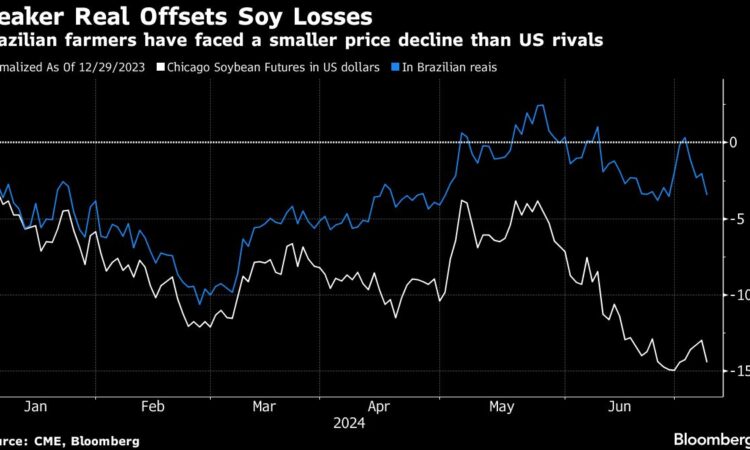
(Bloomberg) — A selloff in Brazil’s currency over the past month is shielding farmers in the world’s top soybean exporter from this year’s price plunge, giving them an edge over US rivals.
Most Read from Bloomberg
The real has lost 11% against the dollar this year — spurred by worries about the nation’s budget gap. That in turn brings about that much more revenue for soybeans than in 2023. The decline in the real has encouraged farmers to boost sales, deepening a rout in benchmark prices that’s eroded revenue for American peers.
Because Brazil is the world’s largest crop exporter, the ups and downs of its currency play a key role in agricultural markets. A weaker real means farmers in the South American nation can better withstand lower commodity prices — which are typically denominated in dollars — than their US counterparts. That would typically encourage exports from the region, putting downward pressure on futures contracts traded in places such as Chicago and New York.
In a clear example of the real’s influence on trading, Brazilian farmers sold more than 4 million metric tons of soybeans in the five days ended July 5, the most for a similar period since October 2020, after the currency plunged to its weakest level in more than two years against the dollar, according to Victor Martins, a risk manager at brokerage firm Amius Ltd.
“This is bad news for US exporters,” Martins said in a phone interview. The currency boost may give Brazilian farmers a competitive advantage lasting well into the fourth quarter, shortening the period in which US suppliers typically have the upper hand, he added.
Soybean futures lost almost 13% — or $1.68 per bushel — this year through Friday as the outlook for ample supplies globally has weighed on prices. The decline is reduced to only 1.7% — or the equivalent of 19 cents — when prices are converted into reais. In Sorriso, a key producing region in Mato Grosso state, cash prices were up 3% year-to-date.
The correlation between soybean prices and the Brazilian real was as high as 59% in June, data compiled by Bloomberg show, meaning the commodity and the Brazilian currency tended to move in the same direction.
After a late start, Brazilian producers are seeking to take advantage of the weaker currency to speed up sales of the commodity for delivery in 2025. SLC Agricola SA, a farming behemoth that cultivates soybeans in an area four times the size of New York City, has locked in prices for nearly 44% of its next crop, up from less than 28% last year and the most since at least three seasons, according to a company filing.
“It was a great opportunity, which we had not expected, especially with futures in decline,” said Eduardo Zorzi, a commercial manager at Grupo Bavaresco, a farming company that plants more than 20,000 acres with soybeans in Mato Grosso state.
To be sure, a weaker currency means Brazilian farmers have to pay more reais for each dollar worth of imported crop nutrients and pesticides, which partly offsets its positive impact on revenue. A Green Markets index of fertilizer prices in the country recently surged to the highest level in more than a year when measured in reais.
The real has over the past few days pared some of its losses, with the Brazilian government seeking to reassure investors of its commitment to fiscal discipline. The currency is expected to end 2024 at 5.20 reais per dollar, strengthening from the current level of about 5.48, according to a central bank survey with economists.
–With assistance from Davison Santana and Jonathan Gilbert.
Most Read from Bloomberg Businessweek
©2024 Bloomberg L.P.
